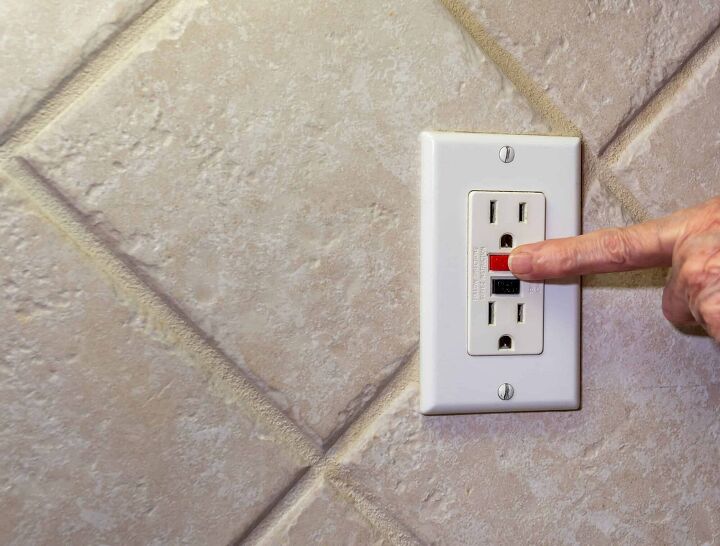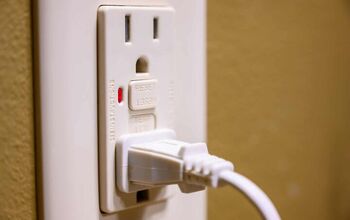GFCI Outlet Not Working? (Possible Causes & How to Troubleshoot)

We often don’t understand how essential electrical outlets are to our daily lives until one stops working. If you’re experiencing only one outlet that’s dead and the others are unaffected, you may simply have a dead outlet. An outlet that isn’t functioning is not only inconvenient, but it can also be a fire hazard. That’s why it needs to be addressed as soon as possible and if you ever feel uncomfortable with the tasks you’re doing, call a professional.
When an outlet has gone dead, it’s easy to quickly jump to conclusions and assume that the worst has happened. However, typically when a GFCI outlet stops working, the fix is relatively simple and often doesn’t require the need to make a service call. It will just require that you engage in a few simple steps to trace the cause.
Regardless, whether it’s a tripped circuit, blown fuse, failed GFCI outlet, or a ground fault at a regular outlet, we’ll explore all the possible reasons why your GFCI outlet is not working. This will help you know where to start when you go to fix the issue.
This guide will take you through the common cause of your GFCI outlet not working and walk you through how you can troubleshoot the issues. That way, you can fix the outlet and have it working like new.
Do You Need to Hire an Electrician?
Get free, zero-commitment quotes from pro contractors near you.

What Is A GFCI Outlet And What Does It Do?
A ground fault circuit interrupter outlet, or GFCI, is a strange set of outlets with the reset and test buttons that may be required in some regions of your home. In accordance with the national residential electrical codes, it is necessary to install a GFCI or GFI outlet if the area where the electrical appliance is obtaining the power source is exposed to the danger of electric shocks or shorting out, such as kitchens and bathrooms.
GFCI outlets essentially protect you and your home against deadly electrical shocks. They do this by detecting leaks within the electrical current and immediately tripping to shut the power off.
You’ll typically find these outlets in bathrooms, garages, kitchens, and basements. However, if they’re not functioning or won’t reset, it’s most often because there is no power supply to the GFCI or the outlet has completely gone bad.
Finding The Problem With Your GFCI Outlet
When you discover a GFCI outlet not working correctly, there are several things that you will want to check, such as:
- Other dead outlets
- A tripped circuit
- Blown fuse
- Tripped GCFI
- Bad connections or loose wires
Looking for these problems will help you understand what is going on so that you can fix your GCFI outlet.
Check For Other Dead Outlets
After noticing that your GFCI outlet is not working, you’ll likely want to head to your circuit breaker. However, you should take a few minutes to check the other outlets, appliances, and lights in your home to see if anything else is being affected.
Using a voltage tester, you can verify whether or not electricity is flowing through the lights. Or, check lights by simply switching them on and off. Also, unplug any appliances that are attached to dead outlets. This will help eliminate the likelihood that short or overload from one of the outlets is causing the problem.
Tripped Circuit Or Blown Fuse
Now that you’ve gone through and checked your outlets, unplugging any that you are concerned about, you can head to the circuit breaker. In order to prevent the circuit from getting any added electrical flow that has the possibility of causing damage or fire, your breaker will become overloaded and shut off.
If you have a tripped circuit breaker, it will be easily identifiable by being flipped to the “off” position. However, in some rare cases, a tripped breaker may appear normal or just slightly out of position. Check for any switches that have a little give to them instead of feeling solid and reset them by switching back to the “on” position.
In order to determine if a fuse has blown, look for evidence of charred glass or a broken filament. Then, replace the burned, blown-out fuse with a new one.
Tripped GFCI Outlet
If you noticed that other outlets on the same circuit as your GFCI outlet are not working, the issue is in the GFCI outlet itself. When a GFCI outlet “pops,” it takes all the other outlets on the same circuit down with it. If you’ve tested and reset your GFCI and it still doesn’t work, it has tripped.
Note: If you notice that every time you try to reset your GFCI, it trips, there may be a dangerous current leak inside the circuit. If this is the case, you should seek help from an electrician.
Symptoms You Need To Examine
- Reset button does not pop out. If the reset button is not popping out when you hit the “test” button, this might mean that either you didn’t push the button is enough for the current to reach the device or your GFCI is defective.
- The reset button does pop out. If your reset button is popping out when turning something on, the GFCI may not have been wired correctly, or the downstream ground fault is the culprit.
- Reset button will not stay in place. If the reset button will not stay in place, the device was improperly wired, or it’s being caused by the existence of a downstream ground fault.
- The reset button is out. If the reset button is out, but devices plugged into it work properly, there may be an inverted line and load. In very rare instances, the circuit interrupter may be completely defective.
- Reset button is in. If the reset button is in, but the devices plugged into it are not working, then the GFCI is defective, not receiving current, or was improperly wired.
Look For Bad Or Loose Connections
If at this point you still aren’t receiving power and the GFCI outlet won’t reset, the next step is to look for any loose connections within the outlet itself. Before you begin, turn off the main circuit breaker in your home. Then, remove your cover and outlet to inspect the electrical box.
Look for any broken or loose wires within the unit. You can do this by carefully bending each wire at the screw terminal. If it is loose, the screw will move, or the wire will turn underneath the screw. Broken wires will be noticeable, but also look for any corroded or burned wires and screws.
Loose Stab-In Connections
In order to save time, some electricians may wire outlets by pressing stripped wires into the holes behind the outlet. Although this method is completely allowed by electrical code, it can loosen over time and cause other problems.
Tug on each wire to look for these loose stab-in connections when you’re troubleshooting the outlet. If you do notice some of these loose connections, do not just reinsert the wire. To fix, you should cut and strip the end and affix it to the screw terminal on the side of the outlet. Or, you can always cut and strip all of the wires and connect them to an entirely new outlet.
Loose Wires At Wire Connectors
To check for any loose wires at the wire connectors, tug on each wire in the bundle to check if anything comes loose. If you do discover a loose wire, you’ll need to remove the connector, cut and strip all of the wires—strip enough to reveal ½ in. to ¾ in. of exposed copper wire.
To reinstall the connector, line up all the wires and twist them clockwise onto the new wire connector. Read the instructions that come with the wire connector to match the correct number of wires to the connector.
When It’s Time To Call A Professional
If you’ve taken the time to check all of the problems listed above but you can’t find anything wrong, or you’ve applied the fixes, and it’s still not working, you will need to call an electrician to assist you. You are limited to what you can do, and an electrician will have all the equipment they could need to fix your GFCI outlet.
Furthermore, if there is faulty wiring somewhere in the wall or a fault within your GFCI outlet that you cannot detect, rest assured, an electrician will be able to find the problem for you.
How Much Does It Cost To Hire An Electrician?
Hiring an electrician can seem costly, but it’s not going to be as much as if you have faulty wiring that catches your house on fire. To hire an electrician, you should expect to pay about $50 to $100 per hour. As far as a GFCI outlet fix goes, the project shouldn’t take more than two hours maximum so that you would pay between $100 and $200 total.
Do You Need to Hire an Electrician?
Get free, zero-commitment quotes from pro contractors near you.

Wrapping It Up
We understand how annoying the existence of a dead GFCI outlet can be. However, more often than not, it’s a simple fix to have it properly functioning again. Whether it was a bad connection, tripped GFCI, blown fuse, or tripped circuit, you should now have a better understanding to help troubleshoot and fix the problem.
For more common outlet issues, check out “ Tamper-Resistant Outlet Can’t Plug-In: Possible Solutions.”

Jessica considers herself a home improvement and design enthusiast. She grew up surrounded by constant home improvement projects and owes most of what she knows to helping her dad renovate her childhood home. Being a Los Angeles resident, Jessica spends a lot of her time looking for her next DIY project and sharing her love for home design.
More by Jessica Stone













![10 Best Cordless Leaf Blowers – [2022 Reviews & Ultimate Guide]](https://cdn-fastly.upgradedhome.com/media/2023/07/31/9070789/10-best-cordless-leaf-blowers-2022-reviews-ultimate-guide.jpg?size=350x220)









![12 Washing Machine Brands to Avoid [with Recall Data]](https://cdn-fastly.upgradedhome.com/media/2023/07/31/9075781/12-washing-machine-brands-to-avoid-with-recall-data.jpg?size=350x220)



